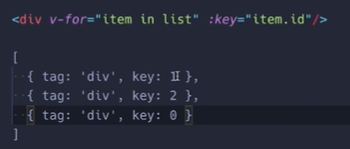虚拟 DOM
虚拟 DOM 层的一些好处
- 它让组件的渲染逻辑完全从真实 DOM 中解耦
- 更直接地去重用框架的运行在其他环境中
- Vue 运行第三方开发人员创建自定义渲染解决方案,目标不仅仅是浏览器,也包括 IOS 和 Android 等原生环境
- 也可以使用 API 创建自定义渲染器直接渲染到 WebGL,而不是 DOM 节点
- 提供了以编程方式构造、检查、克隆以及操作所需的 DOM 操作的能力
渲染函数
模板会完成你要做的事,在 99%的情况下你只需写出 HTML 就好了,有时候需要做一些更可控的事情,这种情况下,需要编写一个渲染函数,所以渲染函数是什么样子的呢?
Vue2 API
javascript
// 这是组件定义中的一个选项,相比于提供一个 template 选项,你可以为组件提供一个渲染函数,在 Vue2 中,你会得到 h 参数直接作为渲染函数的参数,可以用它创造 vnode
render(h) {
// vnode 接收的第一个参数是 type
return h('div', {
// 第二个参数是一个对象,包含 vnode 上的所有数据或属性;
// Vue2 中的 API 比较冗长,必须指明传递给节点的绑定类型,如果要绑定属性,你必须把它嵌套在 attrs 对象下,如果要绑定时事件侦听器,你得把它绑定在 on 下面
attrs: {
id: 'foo'
},
on: {
click: this.onClick
}
// 第三个参数是这个 vnode 的子节点,直接传递一个字符串是一个方便的 API 去表明此节点只包含文本子节点,但它也可以是数组,包含跟多的子节点,这个数组可以嵌套跟多的嵌套 h 调用
}, 'hello')
}Vue3 API
- Flat props structure(扁平的 props 结构)
- Globally imported `h` helper(全局导入 h)
- 因为 Vue2 的 h 需要连续传递,所以设置为全局变量
javascript
import {h} from 'vue'
render(){
// 当你调用 h 时,第二个参数现在总是一个扁平的对象,你可以直接给它传递一个属性;
// 任何带 on 的都会自动绑定为一个监听器,所以不必考虑太多嵌套的问题
// 大多数时候你也不必考虑是应将其作为 attribute 绑定,还是 DOM 属性绑定,因为 Vue 将智能地找到最好方法
// 实际上,检查这个 key 是否存在,在原生 DOM 中作为属性,如果存在,我们会将其设置为 property,如果不存在,我们将其设置为一个 attribute
return h('div', {
id: 'foo'
onClick: this.onClick
}, 'hello')
}什么时候去使用渲染函数
静态结构的写法
javascript
import {h} from 'vue'
const App = {
render(){
return h('div', {
id: 'hello'
})
}
}html
上述代码最终会得到类似于以下的代码:
<div id=hello></div>
在最终的 dom 里面然后,你可以给它嵌套更多的嵌套子元素
javascript
const App = {
render(){
return h('div', {
id: 'hello'
}, [
h('span', 'world')
])
}
}html
上述代码最终会得到类似于以下的代码:
<div id=hello><span>world</span></div>
在最终的 dom 里面使用 v-if
javascript
// 使用是三目表达式或者普通的 if-else,是一样的
const App = {
render(){
// v-if="ok"
return this.ok
? h('div', {id: 'hello'}, [h('span', 'world')])
:this.otherCondition
?h('p', 'other branch')
:h('span')
}
}使用 v-for
javascript
import {h} from 'vue'
const App = this: {
render()
// v-for
return this.list.map(item => {
return h('div', {key: item.id}, item.text)
})
}处理插槽
javascript
import {h} from 'vue'
const App = {
render(){
const slot = this.$slot.default
?this.$slots.default()
:[]
}
}例子
假设我们有一个堆栈组件,一些用户界面库可能会有这种情况吗,堆栈组件时布局组件
vue
<Stack size="4">
<div>hello</div>
<Stack size="4">
<div>hello</div>
<div>hello</div>
</Stack>
</Stack>
<div class="stack">
<div class="mt-4">
<div>hello</div>
</div>
<div class="mt-4">
<div class="stack">
<div class="mt-4">
<div>hello</div>
</div>
</div>
</div>
</div>
<script>
import {h} from 'vue'
const Stack = {
render(){
const slot = this.$slots.default
?this.$slots.default()
:[]
// 所有内容放进 stack 类中
return h('div', { class: 'stack'}, slot.map(child =>{
return h('div', {class: `mt-${this.$props.size}`},[
child
])
}))
}
}
</script>实际使用:
vue
<script src="https://unpkg.com/vue@next"></script>
<style>
.mt-4{
margin:10px;
}
</style>
<div id="app">
</div>
<script>
const {h,createApp} = Vue
// 使用渲染函数生成的 Stack 组件
const Stack = {
render(){
const slot = this.$slots.default
?this.$slots.default()
:[]
// 所有内容放进 stack 类中
return h('div', { class: 'stack'}, slot.map(child =>{
return h('div', {class: `mt-${this.$props.size}`},[
child
])
}))
}
}
// 使用 Stack 组件
const App = {
components: {
Stack
},
template: `
<Stack size="4">
<div>hello</div>
<Stack size="4">
<div>hello</div>
<div>hello</div>
</Stack>
</Stack>`
}
createApp(App).mount('#app')
</script>效果:

经验:什么时候使用 render
- 当你意识到你想表达的逻辑使用 JavaScript 更容易表达,而不是模板语法
- 当你创作可重用的功能组件时更常见,要跨多个应用程序共享或者组织内部共享
- 你主要在编写特性组件,模板通常是有效的方式
- 模板的好处是更简单,优化通过编译器优化,尤其当你有很多标记的时候
- 它更容易让设计师接管组件并用 CSS 设置样式
创造一个 mount 函数
一些假设让例子更简单:
- 一切都是一个元素
- 调用参数总是一样的顺序(tag, props, children),所以下面有如果你没有任何的属性,你需要在那里传入 null 参数
html
<div id="app">
</div>
<script>
function h(tag, props, children){
return {
tag,
props,
children
}
}
// mount 会接收我们所说的 vnode,contianer 是 DOM 元素
function mount(vnode, container){
// 中间的 vnode.el 是为了后续实现 patchh
const el = vnode.el= document.createElement(vnode.tag) // 这给了我们实际的节点对应于虚拟节点
// props: 如果有,我们需要迭代这些属性把它们分别放在元素上作为 DOM 的 property 或 attribute
if(vnode.props){
// 这里为了简单,就假设一切都是 attribute
for (const key in vnode.props){
const value= vnode.props[key]
el.setAttribute(key, value)
}
}
// children: 假设这个参数是一个虚拟节点数组或者是一个字符串
if(vnode.children){
if(typeof vnode.children === 'string'){
el.textContent = vnode.children
}else{
vnode.children.forEach(child => {
mount(child, el)
})
}
}
// 把它插入容器
container.appendChild(el)
}
const vdom = h('div', {class: 'red'},[
h('span', null, ['hello'])
])
mount(vdom, document.getElementById())
// n1 是旧的虚拟 DOM,之前的快照,n2 是新的虚拟 DOM,是我们现在想要展示在界面的部分
// patch 需要找出最小数量它需要执行的 DOM 操作
function patch(n1, n2){
...
}
const vdom2 = h('div', {class: 'green'},[
h('span', null, ['changed'])
])
patch(vdom, vdom2)
</script>我们渲染了原始组件,把它变成了虚拟 DOM,当一个响应式属性被更新的时候,触发了重新渲染,重新生成了另一个表示形式的虚拟 DOM,然后新旧比较。
创建 patch 函数
html
<div id="app">
</div>
<script>
function h(tag, props, children){
return {
tag,
props,
children
}
}
function mount(vnode, container){
const el = vnode.el= document.createElement(vnode.tag)
if(vnode.props){
for (const key in vnode.props){
const value= vnode.props[key]
el.setAttribute(key, value)
}
}
if(vnode.children){
if(typeof vnode.children === 'string'){
el.textContent = vnode.children
}else{
vnode.children.forEach(child => {
mount(child, el)
})
}
}
container.appendChild(el)
}
const vdom = h('div', {class: 'red'},[
h('span', null, ['hello'])
])
mount(vdom, document.getElementById())
// n1 是旧的虚拟 DOM,之前的快照,n2 是新的虚拟 DOM,是我们现在想要展示在界面的部分
// patch 需要找出最小数量它需要执行的 DOM 操作
function patch(n1, n2){
// 这里仅讨论相同类型需要做的工作
if(n1.tag === n2.tag){
// 中间这部是为了在以后的更新中成为未来的快照
const el = n2.el = n1.el
// props
// 这里不讨论 n1,n2 的 props 是否为空的四种分支情况
const oldProps = n1.props || {}
const newProps = n2.props || {}
for(const key in newProps){
const oldValue = oldProps[key]
const newValue = newProps[key]
// 只有在实际变化后才会调用,以最小化实际 DOM API 的调用
if(newValue !== oldValue){
// 旧的没有,set 会添加,旧的有 key,set 会替换
el.setAttribute(key, newValue)
}
}
// 接下来讨论 key 不在 newProps 中的时候
for (const key in oldProps){
if(!(key in oldProps)){
el.removeAttribute(key)
}
}
// children
const oldChildren= n1.children
const newChildren = n2.children
if(typeof newChildren === 'string'){
if(typeof oldChildren === 'string'){
if(newChildren !== oldChildren){
el.textContent = newChildren
}
}else{
// 使用文本直接覆盖现有的 DOM 节点并丢弃它们
el.textContent = newChildren
}
}else{ // newC 是 arr 的情况
if(typeof oldChildren === 'string'){
el.innreHTML = '' // 清理,然后这个元素变为空元素
// 加入
newChildren,forEach(child => {
mount(child, el)
})
}else{ // 都是数组的情况
const commonLength = Math.min(oldChildren.length, newChildren.length)
for (let i = 0; i < commonLength; i++){
patch(oldChildren[i], newChildren[i])
}
if(newChildren.length > oldChildren.length){
mount(child, el)
}else if(newwChildren.length < oldChildren.length){
oldChildren.slice(newChildren.length).forEach(child => {
el.removeChild(child.)
})
}
}
}
}else{
// repalce
}
}
const vdom2 = h('div', {class: 'green'},[
h('span', null, ['changed'])
])
patch(vdom, vdom2)
</script>props:
可以看到,patch 函数做了相当大的工作,遍历了两个对象,但是有了编译器,给了我们很多的提示,完全跳过这一部分是可能的;
children:
Vue 内部比较数组的一种模式
键模式:当你使用 v-for 并提供一个 key,key 作为节点位置的提示
